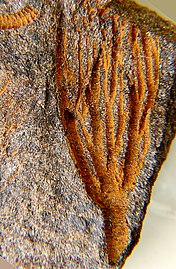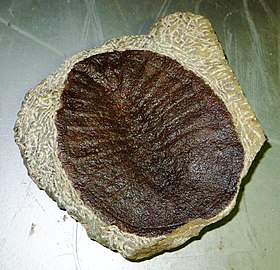Letná Formation
The more than 600 metres (2,000 ft) thick formation comprises a rhythmic alternation of sandstones (greywackes and subgreywackes), quartzites, intercalated with siltstones and shales deposited in marine flysch-like environments.
Because of the excellent preservation, including gut remains, of a wide assemblage of early Paleozoic taxa in which trilobites dominate, the formation, which is lean in fossils in many areas but exceptionally rich in what has been interpreted as storm beds, has been designated a Konservat-Lagerstätte.
Description
The Letná Formation was first formally defined in 1966 by Havlíček and Vaněk and crops out in the Prague Basin, a northeast–southwest trending minibasin stretching over 100 kilometres (62 mi) between Rokycany in the southwest and Úvaly in the northeast. The Prague Basin contains an Ordovician to Devonian succession in the larger Bohemian Massif. The formation conformably overlies the Libeň Formation and is overlain by the Vinice Formation. The Letná Formation is the thickest unit in the sedimentary sequence with a thickness of more than 600 metres (2,000 ft) between Beroun and Prague.
The formation consists of a rhythmic alternation of sandstones (greywackes and subgreywackes), quartzites, intercalated with siltstones and shales with limestone lenses in the upper part of the succession, deposited in a shallow marine environment, representing a flysch deposition in the early Paleozoic. While in most of the layers fossils are absent, certain levels contain a rich assemblage of shallow marine fauna interpreted as storm-induced beds. The concentration of a wide variety of excellently conserved fossils of the Letná Formation has granted it the name of a Konservat-Lagerstätte, giving insight into the diversification of marine ecosystems.
A rather diverse fauna composed of brachiopods, trilobites, echinoderms, conularids, and non-trilobite arthropods has been found in outcrops located between Zdice and Chrustenice. This area probably represented a rather shallow environment in the northwestern part of the basin. The fossils are usually fragmentary and preserved as internal or external moulds associated with angular claystone fragments within quartzose sandstones to siltstones. Accumulations of these fossil remains are commonly found in thick-bedded quartzose sandstones of light-grey and yellow or grey-brown color, which might have been deposited in areas sheltered from wave activity by sand bars.
Five communities of marine fauna were identified in the formation. The rich brachiopod dominated Drabovia Community is associated with shallow water, well-sorted quartzose sandstones. The Bicuspina Community, which probably represents a slightly deeper environment, is typically found in the poorly sorted greywackes of the higher horizons of the Letná Formation. These two communities constitute the Drabovia-Aegiromena Fauna. In more proximal environments, this fauna is replaced by the trilobite-dominated Dalmanitina-Deanaspis Association, which contains Birmanites ingens and Selenopeltis buchi. The more distal, probably deeper parts of the basin are characterized by a poorly diversified assemblage of trilobites associated with rare graptolites. Lastly, trilobites of the so-called Cyclopygid Biofacies and brachiopods of the Paterula Association are typical for the deepest portions of the Prague Basin. Intertidal (Skolithos ichnofacies) and near-shore (Cruziana ichnofacies) environments are also evidenced by ichnofossils.
Fossilized gut remains have been observed in four of the about twenty trilobite species present in the Letná Formation: Birmanites ingens, Dalmanitina socialis, Deanaspis goldfussi and Selenopeltis buchi. These four trilobites belong to the Dalmanitina-Deanaspis Association, characterizing rather proximal and shallow environments of the Letná Formation. Most of the non-trilobite arthropods discovered in this formation, including forms with non-mineralized exoskeletons, are also found associated with D. goldfussi and/or D. socialis. This suggests that the development of conditions conducive to soft-tissue fossilization was not uncommon in the environment represented by the Dalmanitina-Deanaspis Association.
Fossil content
The following fossils were reported from the formation:
- Trilobites
- Actinopeltis completa
- Birmanites ingens
- Calymenella parvula
- Caryon bohemicus
- Cekovia transfuga
- Colpocoryphe grandis
- Dalmanitina socialis
- Deanaspis goldfussi
- Eudolatites dubia
- Eccoptochile (Eccoptochile) clavigera
- Eccoptochile (Eccoptochiloides) tumescens
- Kloucekia phillipsi
- Pharostoma pulchrum
- Placoparia (Hawleia) grandis
- Plaesiacomia rara
- Platycoryphe bohemica
- Primaspis (Primaspis) primordialis
- Selenopeltis buchi
- Stenopareia panderi
- Vysocania moraveci
- Zeliszkella (Zeliszkella) hawlei
- Girvanopyge sp.
- Heterocyclopyge sp.
- Prionocheilus sp.
- Non-trilobite arthropods
- Crinoids
- Lingulata
- Gastropods
- Paragastropoda
- Bivalves
- Crustaceans
- Ostracods
- Rostroconchia
- Blastoidea
- Rhynchonellata
- Craniata
- Strophomenata
- Tergomya
- Tentaculita
- Edrioasteroidea
- Eocrinoidea
- Stylophora
- Soluta
- Scyphozoa
- Merostomata
- Polychaeta
- Machaeridia
- Algae
- Other
Gallery
-
Bicuspina multicostellata
-
Caleidocrinus multiramus
-
Duslia insignis
-
Holopea praestans
See also
References
- ^ Kříž & Steinová, 2009
- ^ Mikuláš, 1998b, p.143
- ^ Fatka et al., 2013, p.96
- ^ Mikuláš, 1998a, p.5
- ^ Fatka et al., 2013, p.97
- ^ Noheljová et al., 2019, p.69
- ^ Fatka et al., 2013, p.98
- ^ Letná Formation at Fossilworks.org
- ^ Polechová, Marika; Zicha, Ondřej; Rak, Štěpán (18 July 2023). "A new pustulose bivalve from the Late Ordovician of the Prague Basin (Czech Republic) and remarks on the diversification of pteriomorphids". Geobios. 81: 135–143. doi:10.1016/j.geobios.2023.04.001.
- ^ Fatka et al., 2013, p.99
- ^ Pereira et al., 2017, p.466
Bibliography
- Nohejlová, Martina; Lefebvre, Bertrand; Nardin, Elise; Fatka, Oldřich; Budil, Petr (2019), New echinoderm Lagerstätte from the Letná Formation (Sandbian, Upper Ordovician) of Bohemia, 10th European Conference on Echinoderms, p. 69, retrieved 2020-05-29
- Pereira, Sofia; Marques da Silva, Carlos; Sá, Artur Abreu; Pires, Miguel; Marques Guedes, Armando; Budil, Petr; Laibl, Lukáš; Rábano, Isabel (2017), "The illaenid trilobites Vysocania (Vaněk & Vokáč, 1997) and Octillaenus (Barrande, 1846) from the Upper Ordovician of the Czech Republic, Portugal, Spain and Morocco", Bulletin of Geosciences, 92 (4): 465–490, doi:10.3140/bull.geosci.1642, hdl:20.500.12468/767
- Fatka, O.; Lerosey-Aubril, R.; Budil, P.; Rak, Š. (2013), "Fossilised guts in trilobites from the Upper Ordovician Letná Formation (Prague Basin, Czech Republic)", Bulletin of Geosciences, 88: 95–104, ISSN 1214-1119, retrieved 2020-05-29
- Kříž, Jiří; Steinová, Marika (2009), Letenský profil, Czech Geological Survey, p. 1, retrieved 2020-05-29
- Mikuláš, Radek (1998a), "Trace fossils from the Letná Formation (Ordovician, Czech Republic)", Sborník Geologických Věd, 34: 5–25, retrieved 2020-05-29
- Mikuláš, Radek (1998b), "Ordovician of the Barrandian area: Reconstruction of the sedimentary basin, its benthic communities and ichnoassemblages" (PDF), Journal of the Czech Geological Society, 43: 143–159, retrieved 2020-05-29
Further reading
- R. J. Horný. 1997. Circumbilical retractor muscle attachment area in the Ordovician trilobed bellerophontoidean gastropod Tritonophon peeli sp. n. (Mollusca). Bulletin of the Czech Geological Survey 72(4):333-338
- F. C. Shaw. 1995. Ordovician trinucleid trilobites of the Prague Basin, Czech Republic. Paleontological Society Memoir 40:1-23
- V. Havlíček and J. Vaněk. 1966. The biostratigraphy of the Ordovician of Bohemia. Sborník Geologických Věd, Paleontologie 8:7-69
- Šnajdr, M., 1956. Trilobiti drabovských a letenských vrstev českého ordoviku. [The trilobites from the Drabov and Letná Beds of the Ordovician of Bohemia]. Sborník Ústředního ústavu geologického, 22, 477-533 [in Czech, with English abstract]
- J. Perner. 1903. Gastropodes, Tome 1: Patellidae et Bellerophontidae 1-164



